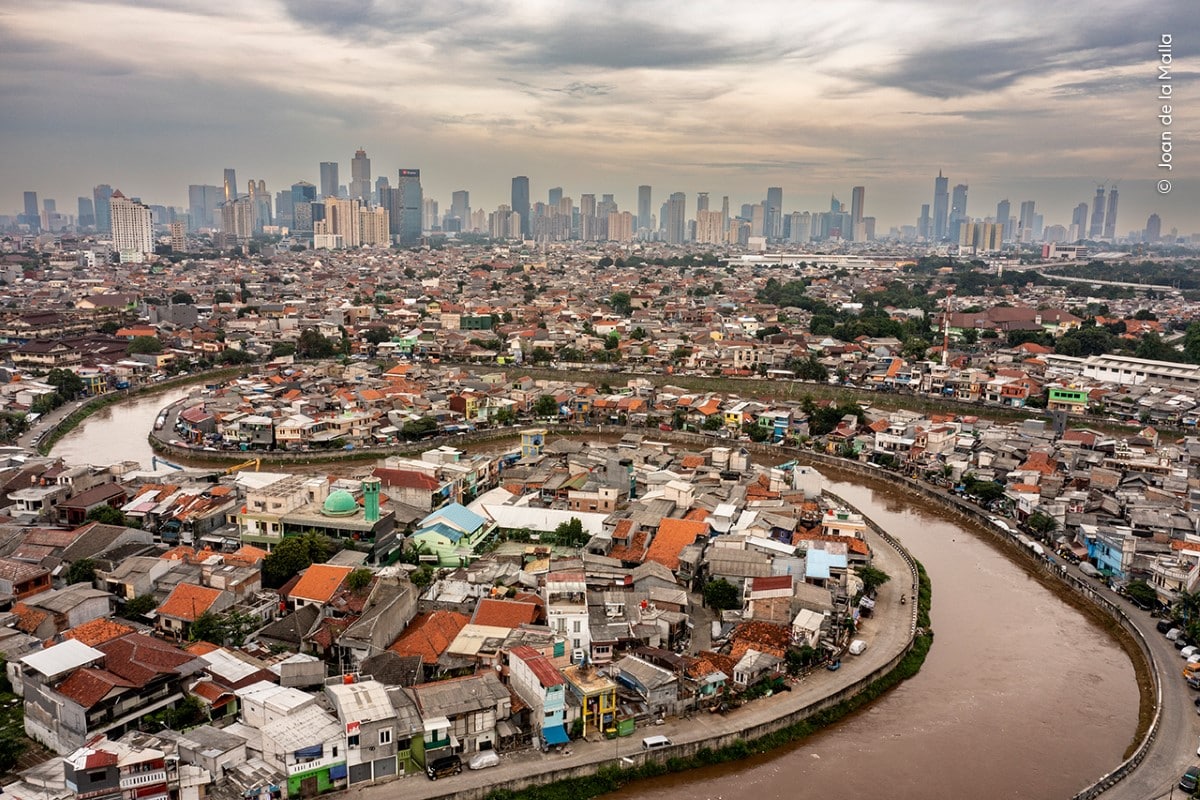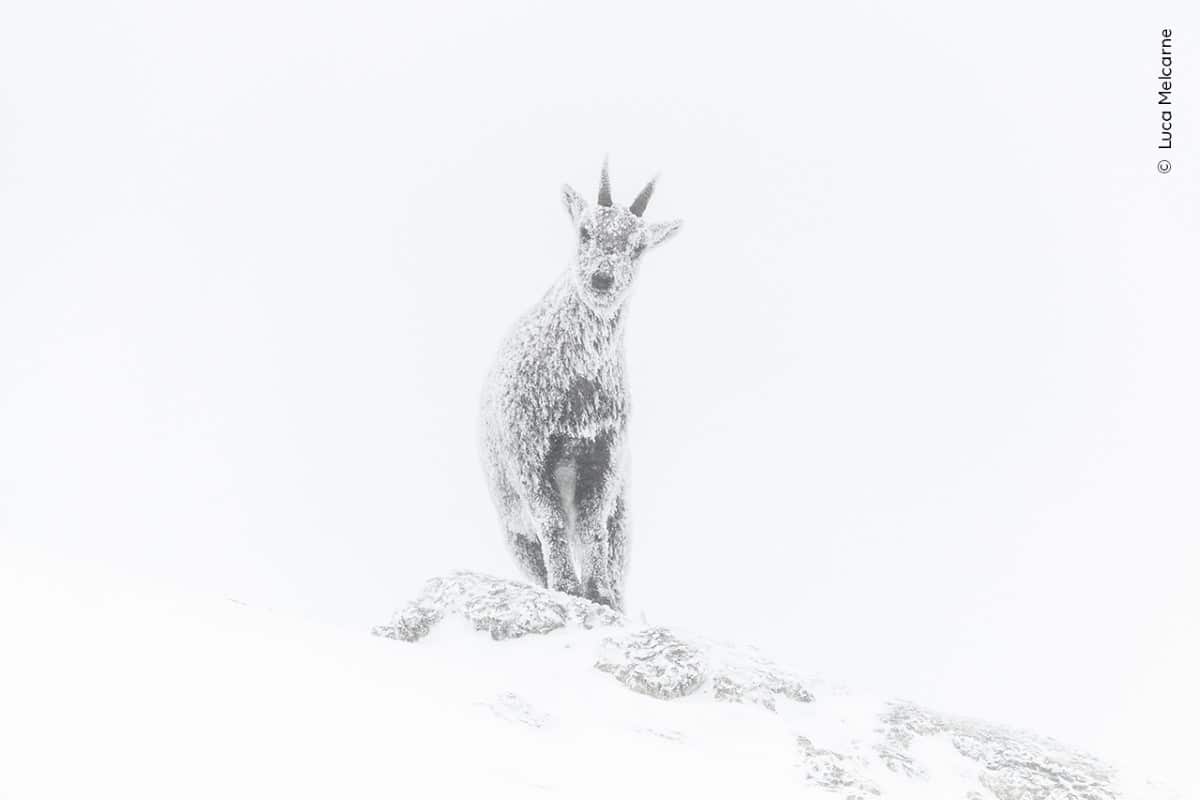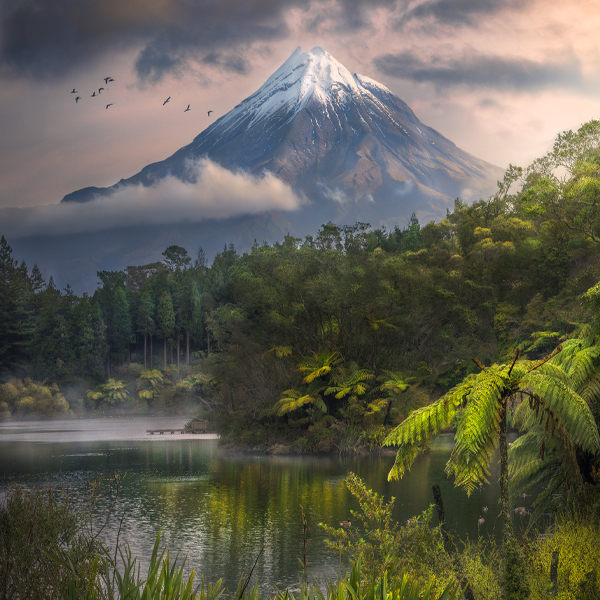
“The ancient mariner” by Laurent Ballesta, France. 2023 Wildlife Photographer of the Year and Winner, Portfolio Award. Location: Pangatalan Island, Palawan, the Philippines. Technical details: Nikon D5 + 13mm f2.8 lens; 1/25 at f22; ISO 800; Seacam housing; 2x Seacam strobes.
“A tri-spine horseshoe crab moves slowly over the mud. Its golden protective carapace hides 12 appendages. Above the horseshoe crab, a trio of juvenile golden trevallies are poised to dart down for edible morsels plowed up by its passage. Laurent Ballesta went looking for horseshoe crabs in the protected waters of Pangatalan Island in the Philippines. Marine biologist and photographer Laurent Ballesta has dedicated his life to exploring the oceans and revealing their wonder through art. He has led a series of major expeditions, all involving scientific mysteries and diving challenges, all resulting in unprecedented images. The tri-spine horseshoe crab has survived for more than 100 million years but now faces habitat destruction and overfishing for food and for its blood, used in the development of vaccines. But, in the protected waters off Pangatalan Island, there is hope for its survival.”
A mesmerizing photo of a golden horseshoe crab beat nearly 50,000 images to win the Natural History Museum's Wildlife Photographer of the Year competition. French underwater photographer and marine biologist Laurent Ballesta took the impressive photo in the Philippines, showing the tri-spine horseshoe crab followed by a trio of golden trevallies.
This species, protected by its hard shell, is the largest of the living horseshoe crabs and has a history dating back 100 million years, but is currently threatened due to habitat destruction and overfishing. Ballesta traveled to the protected waters off Pangatalan Island in the Philippines to document these impressive creatures and was handsomely rewarded with the competition win. After first winning in 2021, this year's win makes Ballesta only the second photographer in the contest's 59-year history to be named Photographer of the Year more than once.
“To see a horseshoe crab so vibrantly alive in its natural habitat, in such a hauntingly beautiful way, was astonishing,” shared jury chair and editor Kathy Moran. “We are looking at an ancient species, highly endangered, and also critical to human health. This photo is luminescent.”
Seventeen-year-old photographer Carmel Bechler was also honored as Young Wildlife Photographer of the Year. Bechler began his journey with photography when he was just 11 years old and won for his dynamic photo of barn owls making their home in an abandoned building. By using long exposure times to capture the passing traffic, he added a special touch to the scene.
“I hope to share with my photography that the beauty of the natural world is all around us, even in places where we least expect it to be,” he shares. “We just need to open our eyes and our minds.”
The two overall winners were selected from the 19 category winners, all of whom show the great diversity of wildlife across our planet. The winning images can be seen in a special exhibition at the National History Museum, London, until June 30, 2024. Take in all the winners below and get ready for the 60th anniversary of the contest, which will open for entries on October 16, 2023.
Here are the winners of the prestigious 2023 Wildlife Photographer of the Year contest.

“Owls’ road house by Carmel Bechler, Israel. Young Wildlife Photographer of the Year and Winner, 15-17 Years. Location: Hof HaSharon, Israel. Technical details: Nikon D7500 + Tamron 18–200mm f3.5–6.3 lens; 1.3 sec at f4.8; ISO 4000.
“Carmel Bechler discovered several barn owls in an abandoned concrete building near a busy road. Returning to where he had spotted a barn owl the previous year, Carmel and his father used the family car as a hide. He made the most of the natural light and used long exposure times to capture the light trails of passing traffic. Israel has the densest barn owl population in the world. A national project has provided nesting boxes near agricultural fields, encouraging owls to nest near farmland. Because the owls hunt rodents that eat seeds and crops, this arrangement has reduced the use of pesticides on farms.”

“Whales making waves” by Bertie Gregory, UK. Winner, Behaviour: Mammals. Location: Antarctic Peninsula, Antarctica. Technical details: DJI Mavic 2 Pro + Hasselblad L1D-20c + 28mm f2.8 lens; 1/120 at f4; ISO 100.
“Bertie Gregory tracks a pod of orcas as they prepare to ‘wave wash’ a Weddell seal. Bertie took two month-long expeditions searching for orcas. ‘We spent every waking minute on the roof of the boat, scanning,’ he says. After battling high winds and freezing conditions, he captured this remarkable behavior with his drone. These orcas belong to a group specializing in hunting seals by charging towards the ice, creating a wave that washes the seal into the water. With rising temperatures melting ice floes, seals are spending more time on land, and the behavior of ‘wave washing’ may disappear.”

“The unprotected” by Karine Aigner, USA. Winner, Photojournalist Story Award. Location: Texas, USA. Technical details: Sony RX1R II + 35mm f2 lens; 1/40 at f8; ISO 1600.
“Contestants line up to have their bobcats weighed in the March 2022 West Texas Big Bobcat Contest, the highest-paying predator-hunting contest in the USA. There are a number of prizes, one of which is for the heaviest bobcat. In 2022 the winner of that category took home US$35,530 (around £28,000). Karine Aigner documents the annual hunting competitions in Texas, USA. For some people in the USA, hunting wildlife is a pastime. In Texas, while there are strict regulations covering ‘game’ species, certain predators such as bobcats, mountain lions, and coyotes have no protection and can be killed at any time and by any means. In this portfolio, Karine delves deep into the contests and festivals that celebrate the killing of these unprotected and maligned species, exploring their relationship with humans.”

“Life on the edge” by Amit Eshel, Israel. Winner, Animals in their Environment. Location: Zin Desert, Israel. Technical details: Canon EOS R5 + 24–70mm f2.8 lens at 45mm; 1/800 at f8; ISO 500.
“Amit Eshel witnesses a dramatic cliffside clash between two Nubian ibex. After hiking to a vantage point on the clifftop, Amit slowly crept closer, using a wide-angle lens to set the action of two clashing Nubian ibex against the dramatic backdrop. The battle lasted about 15 minutes before one male surrendered, and the pair parted without serious injury. In the run-up to the mating season, part of the males’ coat darkens, and their neck muscles thicken. Rivals will raise up on their hind legs and ram their heads together. Their horns sometimes break as they collide.”

“The dead river” by Joan de la Malla, Spain. Winner, Wetlands – The Bigger Picture. Location: Ciliwung River, Jakarta, Indonesia. Technical details: DJI Mavic 2 Pro + Hasselblad L1D-20c + 28mm f2.8 lens; 1/25 at f6.3; ISO 100.
“Joan de la Malla provides a bird’s-eye view of the polluted Ciliwung river winding through Indonesia’s capital, Jakarta. To find a time when lower air pollution allowed a clear view, Joan returned to the scene over several days. His image documents one of the most polluted rivers in the world and illustrates the growing global issue of river pollution. Plastic rubbish, human waste, agricultural fertilizers, and factory waste suffocates the Ciliwung River. As a result, Jakarta’s residents have to use groundwater for drinking water. This has resulted in widespread subsidence, and the city is now sinking.”

“The wall of wonder” by Vihaan Talya Vikas, India. Winner, 10 Years and Under. Location: Nallur Heritage Tamarind Grove, Karnataka, India. Technical details: Canon EOS 7D Mark II + Laowa 15mm f4 lens; 1/200 at f5.6; ISO 100; Vanguard tripod.
“Vihaan Talya Vikas watches as an ornamental tree trunk spider prevents its prey from escaping. This was Vihaan’s first visit to the tamarind grove. Fascinated by stories of the Hindu god Krishna, it seemed to Vihaan as if the spider had positioned its web after being entranced by the sound of Krishna’s flute. This spider is an orb weaver, which creates a wheel-shaped web of sticky threads to catch flying insects. As the spider grows, it elongates its web, which entangles anything that lands on it.”

“Alpine exposure” by Luca Melcarne, France. Winner, Rising Star Portfolio Award. Location: Vercors Regional Natural Park, Rhône-Alpes, France. Technical details: Nikon D850 + 600mm f4 lens; 1/5000 at f4.5 (+1 e/v); ISO 640.
“To enable an early ascent into ibex territory, Luca had spent a bitterly cold night in a temporary shelter in the French Alps, having skied for six hours across the natural park. Luca thawed his camera with his breath and took the ibex’s portrait. Luca Melcarne makes the most of his mountain guide skills to reveal the fascinating lives of Alpine animals. Born at the foot of the Vercors mountains in France, Luca is a professional mountain guide and nature photographer. He is addicted to the cold, constantly watching the weather to make his plans. This portfolio highlights the animals that live in the Vercors Regional Natural Park, where Luca lives and works. His remarkable images demonstrate how patience, perseverance, and passion are essential ingredients for dramatic wildlife photography.”
49,957 photographs from photographers in 95 countries were submitted for consideration.

“Out of the blue” by Ekaterina Bee, Italy. Winner, 11-14 Years. Location: Portree, Isle of Skye, Scotland, UK. Technical details: Nikon D5600 + 18–55mm f3.5–5.6 lens; 1/1600 at f4.8; ISO 320.
“Ekaterina Bee shares her intimate encounter with some common bottlenose dolphins. Ekaterina’s trip to the west coast of Scotland was filled with wildlife encounters, but bottlenose dolphins were an unexpected surprise. From the boat, she composed this image, which highlights the surface patterns on the water created by the dolphins’ movements. Common bottlenose dolphins can be found throughout the world’s oceans except in polar regions. Living in small groups, they are highly social animals, and are one of the top marine predators living in Scottish waters.”

“The tourism bulldozer” by Fernando Constantino Martínez Belmar, Mexico. Winner, Photojournalism. Location: Paamul, Quintana Roo, Mexico. Technical details: DJI Mavic Mini 2 + 24mm f2.8 lens; 1/320 at f2.8; ISO 100.
“Fernando Constantino Martínez Belmar (Mexico) shows the devastating path of a new cross-country tourist railway line. To reach a point from where he could launch his drone, Fernando was guided through four kilometers (2.5 miles) of an underground cave system. The result of his challenging trek was this image. The government-funded railway line connecting tourist destinations brings economic benefits to Mexico’s southeast, but it also fragments ecosystems, threatens protected reserves and archaeological sites, and impacts Indigenous peoples. While trains are a more environmentally friendly form of transport, conservationists warn of devastating consequences.”

“Lights fantastic” by Sriram Murali, India. Winner, Behaviour: Invertebrates. Location: Anamalai Tiger Reserve, Tamil Nadu, India. Technical details: Canon 6D + 24mm f1.4 lens; 19 sec at f2; multiple exposures; ISO 6400; cable release; Manfrotto tripod.
“Sriram Murali showcases a night sky and a forest illuminated with fireflies. Sriram combined fifty 19-second exposures to show the firefly flashes produced over 16 minutes in the forests near his hometown. The firefly flashes start at twilight, with just a few, before the frequency increases, and they pulse in unison like a wave across the forest. Fireflies, which are, in fact, beetles, are famous for attracting mates using bioluminescence. Darkness is a necessary ingredient in the success of this process. Light pollution affects many nocturnal creatures, but fireflies are especially susceptible.”

“The tadpole banquet” by Juan Jesús Gonzalez Ahumada, Spain. Winner, Behaviour: Amphibians and Reptiles. Location: Ojén, Málaga, Spain. Technical details: Canon EOS R6 + 100mm f2.8 lens; 1/80 at f5.6; ISO 320; ring flash.
“Juan Jesús Gonzalez Ahumada watches as toad tadpoles feast on a dead fledgling sparrow. The drama unfolded near Juan’s home when a newly fledged sparrow launched itself from a nest on his neighbor’s roof and fell into a nearby pond, where it drowned. Juan had to pick his moment to show the tadpole formation and the sparrow’s eye. Common toad tadpoles have varied diets consisting of algae, vegetation, and tiny swimming invertebrates. As they grow larger, they become more carnivorous, so when a banquet like this arrives, they take full advantage.”

“Last gasp” by Lennart Verheuvel, the Netherlands. Winner, Oceans: The Bigger Picture. Location: Cadzand-Bad, Zeeland, the Netherlands. Technical details: Canon EOS R5 + 100–500mm f4.5–7.1 lens at 100mm; 1/80 at f7.1; ISO 1250.
“Lennart Verheuvel shows the final moments of a beached orca. Lying on its side in the surf, this orca had only a short time to live. Initially rescued, it was soon stranded again on the beach and died. A study later revealed that not only was it severely malnourished, it was also extremely sick. Research shows that orcas in European waters have the world’s highest concentrations of polychlorinated biphenyls. These banned chemicals can persist for many years in marine food webs, weakening immune systems and reducing breeding success in whales, porpoises and dolphins.”

“Hippo nursery” by Mike Korostelev, Russia. Winner, Underwater. Location: Kosi Bay, iSimangaliso Wetland Park, South Africa. Technical details: Canon EOS 5D Mark III + 17–40mm f4 lens; 1/320 at f7.1; ISO 640; Seacam housing.
“Mike Korostelev reveals a hippopotamus and her two offspring resting in the shallow clear-water lake. For over two years, Mike has been visiting the hippos in this lake and knew they were accustomed to his boat. He spent just 20 seconds underwater with them—enough time to get this image from a safe distance and to avoid alarming the mother. Hippos produce one calf every two to three years. Their slow-growing population is particularly vulnerable to habitat degradation, drought, and illegal hunting for meat and ivory from their teeth.”

“Silence for the snake show” by Hadrien Lalagüe, France. Winner, Behaviour: Birds. Location: Guiana Space Center, between Kourou and Sinnamary, French Guiana. Technical details: Canon EOS 100D + 10–20mm f4.5–5.6 lens at 11mm; 1/60 at f10; ISO 1600; 2x Nikon flashes; Panasonic PIR motion sensor; custom housing.
“Hadrien Lalagüe is rewarded for his patience with a perfect alignment of grey-winged trumpeters watching a boa slither past. Hadrien set up his camera trap by a track in the rainforest surrounding the Guiana Space Center. He spent the next six months maintaining the camera kit against high humidity, plastic-munching ants, and damage by poachers. This image was his reward. Trumpeters—named for their loud calls—spend most of their time foraging on the forest floor, eating ripe fruits, insects, and the occasional small snake. The boa constrictor, more than three meters (9.8 feet) long, could have made a meal of them.”

“Birds of the midnight sun” by Knut-Sverre Horn, Norway. Winner, Urban Wildlife. Location: Vardø, Troms og Finnmark, Norway. Technical details: Canon EOS R5 + 24–70mm lens at 42mm; 1/5000 at f8; ISO 100.
“Knut-Sverre Horn offers a glimpse of kittiwake chicks illuminated in an abandoned factory. From his vantage point inside an abandoned fish-processing factory, Knut-Sverre kept watch on the black-legged kittiwakes tending to their chicks on the windowsill. As midnight approached, the low summer sun struck the north-facing window, sharpening the birds’ silhouettes and giving him the image he wanted. Kittiwakes naturally nest on the narrow ledges of high, steep coastal cliffs. Recently numbers have plummeted, and some have headed for urban areas due to shortages of food caused by warming oceans and pollution.”

“Last breath of autumn” by Agorastos Papatsanis, Greece. Winner, Plants and Fungi. Location: Mount Olympus, Pieria, Greece. Technical details: Nikon D810 + 105mm f2.8 lens; 1/40 at f36; ISO 500; Godox flash + trigger; Leofoto mini tripod.
“Agorastos Papatsanis reveals the magic of a fungus releasing its spores in the forest. Long fascinated by fungi, Agorastos used his silver photographic umbrella to stop his camera from getting wet and covered his carefully positioned flash with a plastic bag. The colorful touches come from the refraction of light passing through the spore-laden air currents and rain. Parasol mushrooms release spores from the gills under their cap. Billions of tiny spores travel—usually unseen—in the air currents. Some will land where there is moisture and food, enabling them to grow networks under the forest floor.”

“Face of the forest” by Vishnu Gopal, India. Winner, Animal Portraits. Location: Tapiraí, São Paulo, Brazil. Technical details: Nikon D850 + 14–24mm f2.8 lens at 14mm; 1/30 at f6.3; ISO 1600; torch.
“Vishnu Gopal records the moment a lowland tapir steps cautiously out of the swampy Brazilian rainforest. Finding hoofprints on a forest track near his campsite, Vishnu waited nearby. An hour later, the tapir appeared. Using a long exposure and torchlight to capture texture and movement, Vishnu framed the tapir’s side-turned head as it emerged from the forest. Lowland tapirs rely on the forest for their diet of fruit and other vegetation, and in turn, the tapirs act as seed dispersers. This important relationship is threatened by habitat loss, illegal hunting, and traffic collisions.”

“The art of courtship” by Rachel Bigsby, UK. Winner, Natural Artistry. Location: Noss National Nature Reserve, Shetland, Scotland, UK. Technical details: Nikon D850 + Sigma 60–600mm f4.5–6.3 lens; 1/1600 at f11; ISO 5000.
“Rachel Bigsby frames a gannet pair against the guano-painted curves of sandstone cliffs. From her boat in turbulent sea swell, Rachel realized that achieving her vision of showcasing gannets set against the towering cliffs would be tricky. But as the boat aligned with the rocks, she spotted this pair ‘isolated on a lower ledge, intertwining their necks and framed by streaks of guano.’ Each summer, the Isle of Noss hosts more than 22,000 northern gannets, which return to breed on the ledges carved by the elements. This species was hardest hit by the 2022 avian flu outbreak.”






















































































